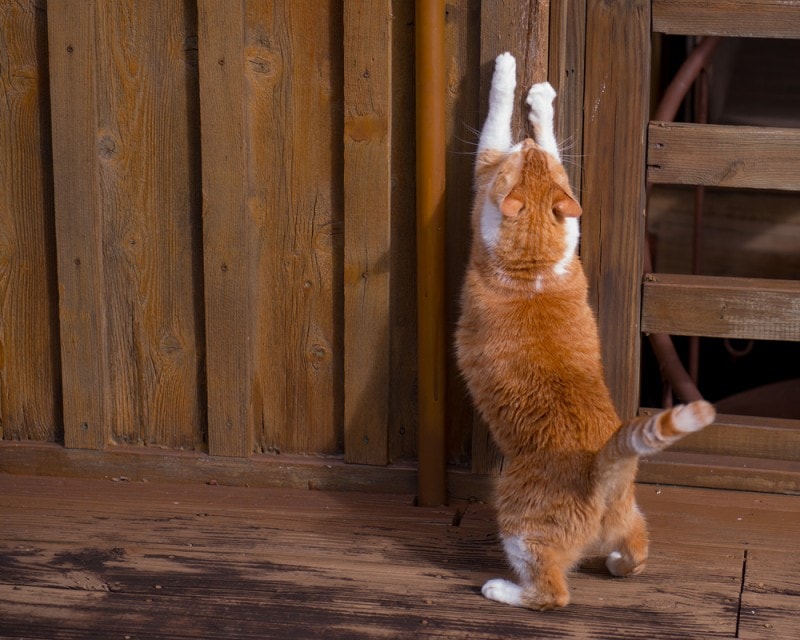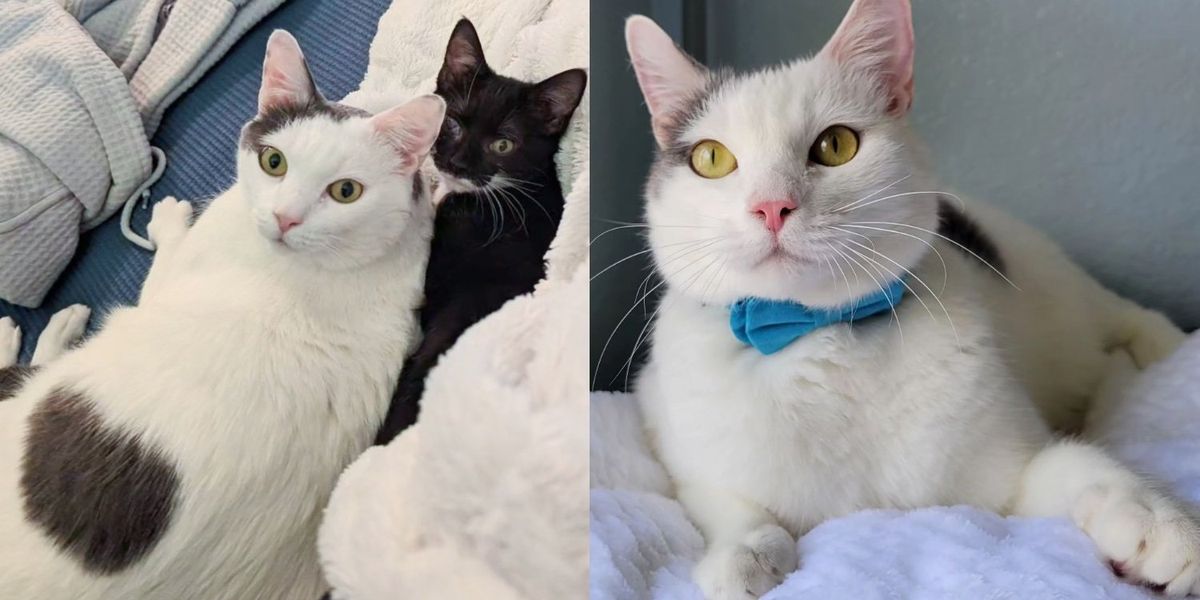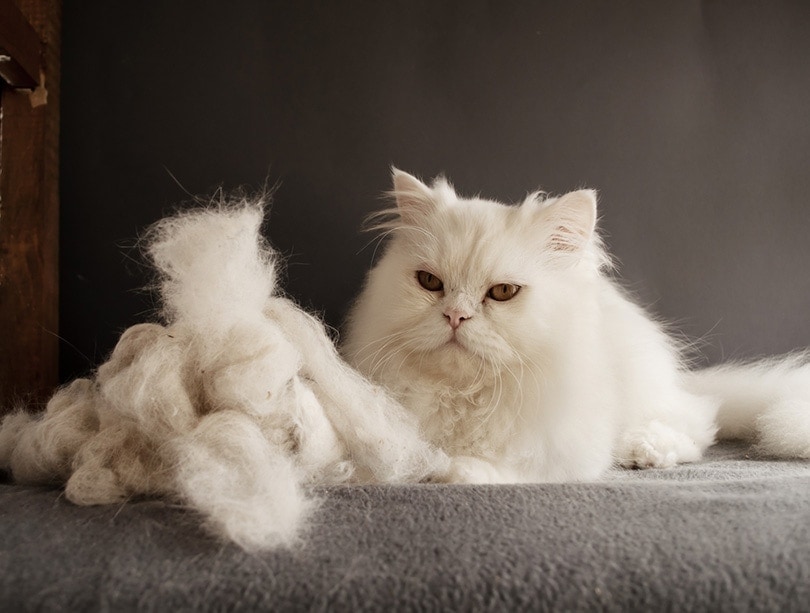Last Updated on: November 6, 2023 by Crystal Uys
There’s no denying that a cat’s paws are adorable, but what they do with their claws isn’t always so cute. Moggies taking out their scratching urges on furniture and walls is a common cat parent complaint, but why do they do this in the first place?
Wall-scratching can become a habit for an assortment of reasons, some innocent and some that may indicate a deeper issue. Let’s delve into the reasons why your wall may have become your cat’s latest victim. We’ll also share some tips on preventing scratching in inappropriate places.
The 6 Reasons Why Cats Scratch the Walls:
1. Habit
As we all know, cats are creatures of routine. They like everything to be in the same place as it always is, whether that’s food and water bowls, litter boxes, or scratching areas. If your cat is scratching your wall, the simplest explanation is that they’ve developed this habit out of routine.
Perhaps your cat started doing it while you were out of the house, so you weren’t always able to catch and redirect the behavior. Another explanation may be that they were allowed to do it as a kitten before you brought them home.

2. Territory Marking
When a cat scratches something, their paw pads (which have scent glands) deposit pheromones. This is a way cats mark their territory, so your cat may have taken a shine to your wall and wishes to claim it as their own. This may seem odd, but perhaps your cat likes this particular spot because it’s close to where their bed is or is in their preferred room.
3. Boredom
Cats are more likely to scratch in inappropriate places if they’re bored. Scratching is soothing to cats and helps them work off pent-up energy, so you might want to consider whether or not your cat is getting enough exercise. Try incorporating play sessions into your daily routine to let your cat work off that excess energy and increase their mental stimulation.

4. Attention-Seeking
If your cat has learned that scratching at the wall gets your attention, they will continue to do it whenever they feel it’s necessary. Usually, it’s best to ignore undesirable attention-seeking behavior, but when the integrity of your wall is at stake, it may be better to try redirecting them to a scratch post.
5. Anxiety
Stress and anxiety can cause unwanted behaviors like scratching areas that shouldn’t be scratched. This is an attempt to self-soothe by performing a natural behavior. Other signs of anxiety in cats include pacing, going to the bathroom outside the litter box, excessive vocalization, dilated pupils, restlessness, excessive grooming, and hypervigilance.
Cats that have experienced trauma or haven’t been socialized properly from a young age are more at risk of developing anxiety, as are cats with an illness. Some cats have separation anxiety, which means they get incredibly stressed when you’re not around. See a vet if you suspect anxiety.

6. Pests in the Wall
If your cat hears pests like mice in the walls of your home, scratching may ensue in an attempt to capture whatever’s scuttling about in there. If your kitty seems intent on scratching their way through certain areas of the wall, it could be time to check for a pest problem.
How to Stop Wall-Scratching
To combat destructive scratching, try placing a scratching post in front of the area your cat targets. If they still try to launch a claw attack on the wall, gently redirect them to the post. Do this consistently until they get the hint. There are scratching posts and boards in a variety of shapes, sizes, and textures, so pick the type you think your cat will be most attracted to.

Other Tips:
- Trim your cat’s nails regularly.
- Provide a few different types of scratch posts around your home for variety.
- Never force your cat’s paws onto a scratch post and drag their claws down it—this will only scare them and make them not want to use it.
- Make sure your cat gets plenty of mental and physical exercise.
- Pay attention to your cat when they’re calm instead of when they’re acting out.
- Schedule play sessions so your cat learns to expect them. This may reduce attention-seeking behaviors.
- Avoid yelling at or punishing your cat—this makes things worse.
- Cats don’t scratch out of spite.
- If you need to, place your cat in another room for a few minutes when they scratch the wall to remove them from the situation.
- Cover the area with something unappealing, like plastic sheeting.
- Consult your vet if you think your cat may have anxiety or another health condition.
Is Declawing a Good Idea?
No! Declawing is a bad idea because it can lead to a number of health issues including pain in the back and paws, tissue death, lameness, nerve damage, bone spurs, and infections. In addition, the recovery process can be difficult and painful. It’s also cruel in the sense that it’s emotionally damaging to your cat because declawing prevents them from performing an essential natural behavior.
Declawing is not like simply having nails trimmed at all—the procedure actually involves cutting through the tendons and sensory and motor nerves. To put things into perspective, declawing to a cat is like a human having the tips of their fingers cut off at the knuckle.
Conclusion
If your cat has been making a scratchboard out of your wall, don’t despair—a solution is sure to be close at hand. Work on identifying the cause to find out whether a cleverly placed scratch post could be the answer or if a more detailed analysis by your vet could be in order.
Featured Image Credit: Yuliya Gallimore, Shutterstock
About the author
Cat mom to Ivy – a feisty little rescue kitten that is her one and only child. For now! Throughout her life, she has been introduced to the special love that can be found in the bond with a cat. Having owned multiple felines, she is more than certain that their love is unmatched, unconditional and unlike any other. With a passion to educate the public about everything, there is to know about felines, their behavior, and their unique personalities, Crystal is devoted to making sure that all cats and their owners know the importance of conscious living – and loving!



